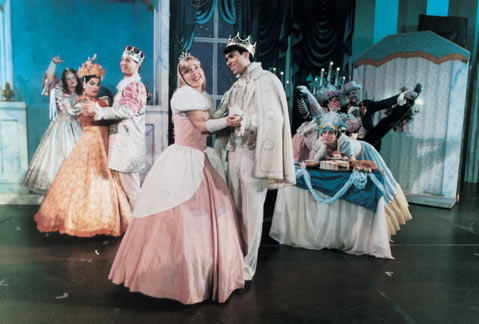Cinderella at UCSB’s Campbell Hall Reviewed
Arts and Lectures Presented the American Family Theater on Sunday, March 18

Cinderella is the classic fairy-tale—the goodhearted servant becomes a princess because she is kind and beautiful. In this original musical, the American Family Theater leaves Cinderella’s story the same, but, as a result of some important additions, the story comes to life in a new way. The new major role is Mortimer Mouse. He’s the prince’s sidekick who quickly befriends Cinderella, greatly aids in carrying the tale along, and makes sure things happen the way they are supposed to. While upholding the classical Cinderella message that kindness is always rewarded, this version also gave the audience of mostly small children an extra message in the song “Smile” where Mortimer Mouse advises Cinderella to always maintain a sunny disposition. Mortimer is the only character who openly and actively engages the audience, and he even finds a way to include them in a pivotal scene when the prince almost leaves before Cinderella arrives at the ball. This participation is a nice addition in a production geared towards younger kids; it subtly reminds them of the overall story while still keeping their attention where it should be—in the moment. Since this American Family Theater production is mainly for younger kids—from toddlers to the low double digits—it makes sense that obvious (mostly physical) humor, bright colors, sparse scenery, and extravagant costumes all play a major roles in the design. They succeed in pulling interest away from candy or toys and towards the actors onstage.
The actors also did a great job of appealing to their main crowd. In another, more mature production of Cinderella or of any play, the actors’ dramatic voices and overdone actions would have been written off as amateur or trying too hard, but for this production, they were just right. With such a young audience, each character not only has to keep the children interested in what is happening onstage; they must also provide an obvious contrast between each character’s persona. The characters of Cinderella and her step-sisters, for example, had to be made quite distinct in order for the little children to see and understand who was the ugly stepsister and who was/deserved to soon be the princess.
There were no superfluous scenes in this Cinderella, only key ones such as the ball and the great shoe search. It would have been nice to see some of the magical disappearances, such as when the carriage turns into a pumpkin again, in order to experience more dramatically the contrast between Cinderella’s servitude and what seems like her one chance at glamour. The children also seemed a bit perplexed when Cinderella mentioned sitting on a pumpkin. Also missed were some other lovable animal characters such as the three mice and the bluebirds that craft Cinderella’s initial dress for the ball in some versions. As for the fairy godmother, she was only in one scene, but her character was emphasized with an entire song about how “if crying won’t do, wishing will.” The rest of the characters stayed true to their fairytale origins.
American Family Theater specializes in child-friendly shows (many of their touring productions are of fairytales like Cinderella), and as a result, they create a great experience for the families with young children. Lots of shows on Broadway now aren’t necessarily appropriate for the little ones, but, with their Cinderella at UCSB, the American Family Theater provided a musical that the entire family could enjoy and still have the authentic theatre experience.



